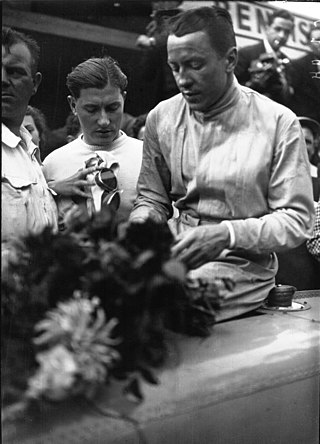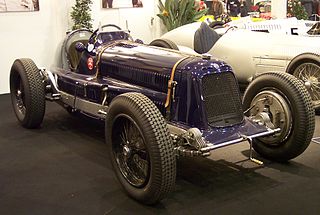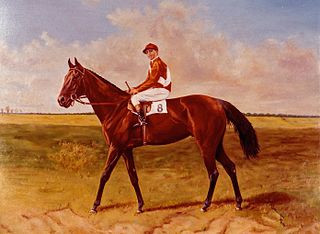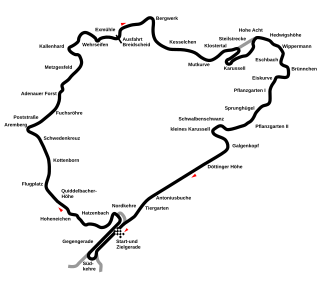
Raymond Pierre Sommer was a French motor racing driver. He raced both before and after WWII with some success, particularly in endurance racing. He won the 24 Hours of Le Mans endurance race in both 1932 and 1933, and although he did not reach the finishing line in any subsequent appearance at the Le Mans, he did lead each event until 1938. Sommer was also competitive at the highest level in Grand Prix motor racing, but did not win a race. He won the French Grand Prix in 1936, but the event that year was run as a sports car race. After racing resumed in the late 1940s, Sommer again won a number of sports car and minor Grand Prix events, and finished in fourth place in the 1950 Monaco Grand Prix, the second round of the newly-instituted Formula One World Drivers' Championship. He was killed toward the end of 1950, when his car overturned during a race at the Circuit de Cadours.

Jean-Pierre Wimille was a Grand Prix motor racing driver and a member of the French Resistance during World War II. Before the war he drove for the French Bugatti team and after the war for the Italian Alfa Romeo. He died in a crash at the 1949 Buenos Aires Grand Prix. He is considered the best driver of his time and one of the greatest French drivers of all time. Five times World Champion Juan Manuel Fangio himself had taken him as a model.
Grand Prix motor racing, a form of motorsport competition, has its roots in organised automobile racing that began in France as early as 1894. It quickly evolved from simple road races from one town to the next, to endurance tests for car and driver. Innovation and the drive of competition soon saw speeds exceeding 100 miles per hour (160 km/h), but because early races took place on open roads, accidents occurred frequently, resulting in deaths both of drivers and of spectators. A common abbreviation used for Grand Prix racing is "GP" or "GP racing".

The Spanish Grand Prix is a Formula One motor racing event currently held at the Circuit de Barcelona-Catalunya. The race is one of the oldest in the world still contested, celebrating its centenary in 2013. The race had modest beginnings as a production car race. Interrupted by the First World War, the race waited a decade for its second running before becoming a staple of the European calendar. In 1927 it was part of the World Manufacturers' Championship; it was promoted to the European Championship in 1935 before the Spanish Civil War brought an end to racing. The race was successfully revived in 1967 and has been a regular part of the Formula One World Championship since 1968 at a variety of venues.

Otto Wilhelm Rudolf Caracciola was a racing driver from Remagen, Germany. He won the European Drivers' Championship, the pre-1950 equivalent of the modern Formula One World Championship, an unsurpassed three times. He also won the European Hillclimbing Championship three times – twice in sports cars, and once in Grand Prix cars. Caracciola raced for Mercedes-Benz during their original dominating Silver Arrows period, named after the silver colour of the cars, and set speed records for the firm. He was affectionately dubbed Caratsch by the German public, and was known by the title of Regenmeister, or "Rainmaster", for his prowess in wet conditions.

Louis Alexandre Chiron was a Monégasque racing driver who competed in rallies, sports car races, and Grands Prix.
Charles Anthony Standish Brooks was a British racing driver also known as the "Racing Dentist". He participated in 39 Formula One World Championship Grands Prix, competing for the first time on 14 July 1956, and achieved six wins, 10 podium finishes and 75 career points. He was third in the World Drivers' Championship in 1958 with Vanwall and second in 1959 with Ferrari. He also scored the first win by a British driver in a British car in a Grand Prix since 1923, driving a Connaught at Syracuse in 1955 in a non-championship race.

Philippe Jean-Armand Étancelin was a French Grand Prix motor racing driver who joined the new Formula One circuit at its inception.
Baconin Borzacchini was an Italian Grand Prix motor racing driver often referred to as Mario Umberto Borzacchini.

The Montjuïc circuit is a former street circuit located on the Montjuïc mountain in Barcelona, Catalonia, Spain. The circuit was also the venue for the Spanish motorcycle Grand Prix from 1950 to 1968, and then hosted the event on even-numbered years until 1976. The last Formula One Grand Prix held there in 1975, is notable for both a fatal crash that led to Formula One abandoning the venue and the only occasion to date that a female driver has scored World Championship points.

The Alfa Romeo P3, P3 monoposto or Tipo B was a classic Grand Prix car designed by Vittorio Jano, one of the Alfa Romeo 8C models. The P3 was first genuine single-seat Grand Prix racing car and Alfa Romeo's second monoposto after Tipo A monoposto (1931). It was based on the earlier successful Alfa Romeo P2. Taking lessons learned from that car, Jano went back to the drawing board to design a car that could last longer race distances.

Heinrich 'Heiri' Suter was a Swiss road racing cyclist. Excelling mainly in the classics, Suter was the first non-Belgian winner of the Tour of Flanders in 1923. Two weeks after his win in the Tour of Flanders, he won Paris–Roubaix, becoming the first cyclist to win both classics in the same year. He also holds a record six victories in Züri-Metzgete, Switzerland's most important one-day race.

The Maserati 8C was a Grand Prix race car built by Maserati between 1931 and 1933. The 8C was being designed by Alfieri Maserati in the early 1930s; however, he died before its completion. The chassis was that of the Maserati Tipo 26M, and it was initially fitted with a Tipo 26M engine with its cylinders bored out by 4 mm to arrive at its limit of 2.8 litres. Development of the new 3.0 L engine continued and it was constructed for racing in 1932. The car won the 1933 French Grand Prix and Sir Henry Birkin achieved third place driving it in the Tripoli Grand Prix. However, it was not very successful in other races. The car featured some of the world's earliest hydraulic brakes. The Tipo 8C 3000 was the final two-seater Grand Prix Maserati, and was succeeded in 1933 by the Maserati 8CM, M for monoposto.

Prince Rose (1928–1944) was a British-bred, Belgian-trained Thoroughbred racehorse, often referred to as the best horse in Belgian racing.

The 1932 French Grand Prix was a Grand Prix motor race held at Reims-Gueux on 3 July 1932. The race lasted for 5 hours, and was not run over a fixed distance.

The 1932 German Grand Prix was a Grand Prix motor race held at the Nürburgring on 17 July 1932.

Joseph "Jef" Scherens was a Belgian professional track cyclist, specializing in sprint where he won seven World Championships.

Count Stanisław Michel Frederic Marie Czaykowski, also known as Stanislas Czaykowski and Stanislaus Czaykowski was a Polish Grand Prix motor racing driver.

Charles Pierre Elie Montier was a French racing driver and automotive engineer whose race entries included the inaugural 24 Hours of Le Mans.

















